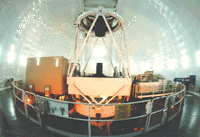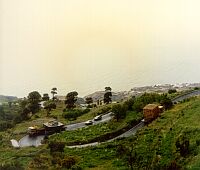The William Herschel Telescope (WHT)
was the third largest single-mirror telescope in the world, when completed
in July 1987.
 To combine the achievement in telescope construction and the new prospects
for observation with a reference to the telescope mounting and the Kingdom
of Spain, it was decided to name the telescope after Sir William Herschel.
It was he who used an altazimuth mount to allow the construction of
telescopes with unprecedented power, one of which, and possibly the best,
was delivered to Madrid Observatory in 1803.
To combine the achievement in telescope construction and the new prospects
for observation with a reference to the telescope mounting and the Kingdom
of Spain, it was decided to name the telescope after Sir William Herschel.
It was he who used an altazimuth mount to allow the construction of
telescopes with unprecedented power, one of which, and possibly the best,
was delivered to Madrid Observatory in 1803.
Installation of the telescope
started in the autumn of 1985 when a part shipment containing the azimuth
bearings and the hydraulic pumping system arrived on site from the UK.
RGO staff who formed the installation team then started the critical job
of installing the azimuth bearings and the plant. The bearings were then
grouted in place by a contractor using a special epoxy grouting system
designed to maintain maximum stiffness between the bearings and the concrete
pier.
 The major shipment of all the
remaining telescope components including the drive system, mirrors and
aluminizing plant was arranged for the spring. The M.V. Ston was chartered
earlier because of the special facilities on the ship for lifting heavy
loads. It sailed on 2 April 1986, arriving in La Palma eight days later.
Pickfords then transported the major parts of the telescope, which totalled
350 tonnes, to site over the next four weeks. Some of the loads were very
large, 6 × 8 metres and weighing 30 tonnes. These presented the haulage
contractor with a number of difficult problems negotiating the very tight
bends and steep gradients on the mountain road.
The major shipment of all the
remaining telescope components including the drive system, mirrors and
aluminizing plant was arranged for the spring. The M.V. Ston was chartered
earlier because of the special facilities on the ship for lifting heavy
loads. It sailed on 2 April 1986, arriving in La Palma eight days later.
Pickfords then transported the major parts of the telescope, which totalled
350 tonnes, to site over the next four weeks. Some of the loads were very
large, 6 × 8 metres and weighing 30 tonnes. These presented the haulage
contractor with a number of difficult problems negotiating the very tight
bends and steep gradients on the mountain road.
Installation started as soon as
loads began to arrive on site and very good progress was made by the RGO
team and its subcontractors during the rest of 1986. The installation of
the cables and control room progressed in parallel, and commissioning using
the telescope control computer started in March 1987. The mirror was aluminized
in May and installed in the telescope shortly afterwards.
The azimuth and altitude bearings
were the first major items to be commissioned and initial tests indicated
that the design natural frequency of 4 Hz for the structure and bearings
had been achieved in practice. This justified the careful mechanical design
and analysis the RGO put into the telescope and eased the task of the servo
control system and software design.
The optical telescope assembly weighs
79,513 kg and including the mounting 186,250 kg.
The budget for the design, erection
and manufacture of the WHT, its control system, dome, building, aluminizing
tank and other plants, and a full set of instrumentation was £15
million (October 1984 prices).
 Articles on the WHT
Articles on the WHT

